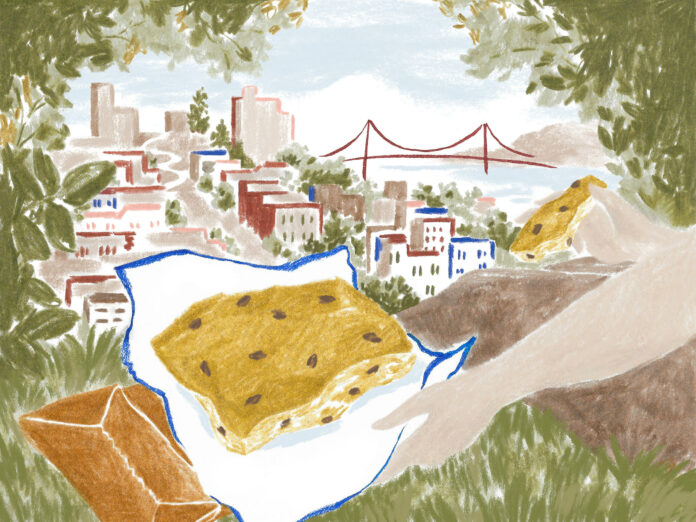An enduring romance with Liguria Bakery focaccia.
by Rachel Markowitz
The sun shone, the sky blazed blue, and the newly unfurled leaves of the London plane trees were a young, fuzz-laden green. But it was eerily quiet along Hyde Street. The cable cars were out of commission. Pedestrians walked along warily. Even Lombard Street was not its usual self: no traffic winding down the red-brick roadway, nary a tourist snapping photos. At one point, the call of an American robin atop a utility pole—cheerily cheer up, cheerily cheer up—was the only sound amid the silence.
It was morning three of the COVID-19 lockdown, back when “shelter-in-place” and “social distancing” were still novel concepts, and distance learning and mandatory face coverings were not yet standard procedure. My two kids and I were out doing permitted activities under the stay-at-home order: taking a walk and buying food. Our destination was Liguria Bakery in North Beach. It was my 26th anniversary in San Francisco, and eating focaccia from Liguria was my long-standing annual ritual. Most establishments in North Beach, and throughout the city, were shut down, so we didn’t know if the bakery would be open. At least we’d get some fresh air.
. . .
I first went to Liguria Bakery in March of 1994. I was 24. I’d arrived by train from Pittsburgh the previous evening, with a duffel bag and a liberal arts degree. That night at the San Remo Hotel, I read a newspaper article about a neighborhood bakery that sold only one thing: focaccia. The piece claimed Liguria’s Italian flatbread was the best in the city, a must-try.
The next morning, I walked to the corner of Filbert and Stockton and pushed through Liguria’s double French doors. There, in a sparsely furnished retail space redolent of flour and yeast, two women presided. The more youthful one stood at the counter; the older one sat on a stool. The younger woman—tall, with dark hair in a ponytail and fingers stained red from tomato sauce—asked if I wanted my focaccia cut—I did, yes—but otherwise kept talking to the other woman, presumably her mother, while filling my order.
I left the shop, grease-stained brown paper bag in hand. I headed up Filbert Street, which culminated in a stairway. At the top of the steps, I turned and took in the view. The undulating patchwork of hills was a dazzling sight, as was the iconic red splendor of the Golden Gate Bridge. I pulled a slab of raisin focaccia from the bag and took a bite. It was soft and chewy and salty and sweet. I had another piece, and another.
. . .
For many years, I retraced my steps each March. I’d visit the ladies at Liguria, buy a bag of focaccia, and walk to the top of the hill.
Some years the pilgrimage inspired musings in my journal:
March 2002: “A peaceful moment. Sunlit bracketed cornice against the blue sky.”
March 2004: “I got to Liguria late, and there was no raisin focaccia left. So now I’m sitting here on someone’s stoop wondering what to do instead.”
Some years I didn’t make it to Liguria, particularly after my first child was born in 2010. Then there was my gluten-free period. In 2018, my 24th year in the city, I found myself at Liguria not in March but later that spring, during my son’s pre-K field trip to Washington Square Park. Promising to bring back a treat, I excused myself from chaperoning and went to Liguria. There was Mary Gebhardt, granddaughter of the bakery’s founder, and her mother, Josephine Soracco, occupying the same stations—counter and stool—as on my very first visit and practically every time since.
In March 2019, Mary’s brother Michael Soracco was at the helm. He said he’d been working at the bakery since 1981 but in back, as baker, a craft he’d learned from his father, George Soracco. George in turn had been schooled by his father, the bakery’s founder, Ambroglio Soracco. Part of the first and largest wave of Italian immigrants to California between 1850 and 1924, the eldest Soracco immigrated to San Francisco from Genoa, capital of the northern Italian region of Liguria. He opened the bakery with his two brothers in 1911.
That morning last year, two employees were out sick, so it was just Michael Soracco and his nephew. He’d been there since 2:00 a.m. He had stacks of flatbread to bundle up and send off to local restaurants, plus there were phone orders coming in and a steady flow of walk-ins to wait on up front. I left him alone and tucked into my purchase.
Like other local specialties—donuts from Bob’s, the sweet baguette from Acme, Tartine Manufactory’s almond croissant—Liguria focaccia sets a high bar of excellence. In accordance with the bakery’s hallowed recipe, the dough is made early each morning from high-gluten flour. It’s hand shaped into 10-by-8-inch flatbreads, punctured with airholes, which create the bread’s characteristic dimpling, and baked in the shop’s original brick oven. Lavishly olive-oiled and generously salted, the plain focaccia is a purist’s delight. The raisin, lightly sweetened and shot through with softened fruit, is a study in salty-sweet harmony. Pizza focaccia is smeared with a rich tomato sauce studded with chopped green onion.
If you want to walk away eating your focaccia, you ask for it cut. A whole flatbread is removed from one of the cooling racks in back and sliced into eight rectangular pieces. White butcher paper is folded around the bread with one side left open, and the bundle is slipped into a brown paper bag, open side facing up. Uncut flatbreads are fully wrapped in the same white paper and tied up with baker’s twine.
A steady stream of customers tinkled through the French doors while I sat there with Soracco. One person had crossed a bridge for Liguria focaccia, and a young couple, travel guide in hand, had crossed an ocean. Regulars asked after Mary and Josephine, and one person groaned about traffic. At 10:50 a.m., Soracco replaced the OPEN sign on the door with a sign that said SOLD OUT. This is part of the Liguria playbook: when they sell out, they close for the day. One undaunted customer snagged the absolute last loaf: onion. To subsequent arrivals Soracco simply said, “I’ve got nothing left.”
. . .
We were thrilled to find Liguria open that morning during the shutdown. “Please respect people’s space,” read a sign on the door referencing the six-foot-distance rule. There were other changes since my 2019 visit. The blue awnings had been replaced with newer versions in a fashionable slate gray. And inside, a previously empty glass case now displayed T-shirts, hoodies, and hats for sale; the hats read “Liguria Bakery: SOLD OUT.” Otherwise, we found the same rows of empty shelves left over from when Liguria was a full-service bakery, the same green, white, and red alphabet sign spelling out the 10 focaccia varieties, the prices, and CASH ONLY.
Two weeks later, we went back to see how they were weathering the crisis. “We’re making half of what we normally make, like everybody else,” said Steve Corbelli, a family friend who was manning the shop.
At the top of Filbert, the kids and I bit into our focaccia and swooned. The pandemic raged on, the economy was tanking, and we didn’t know when things would feel normal again. But for one moment, nothing in the world had changed at all. ♦
Rachel Markowitz is an SF mom and a freelance proofreader specializing in cookbooks. She spends her me time reading, writing, taking walks, and cooking (or daydreaming about it). She also serves as copy editor for The San Franciscan.



